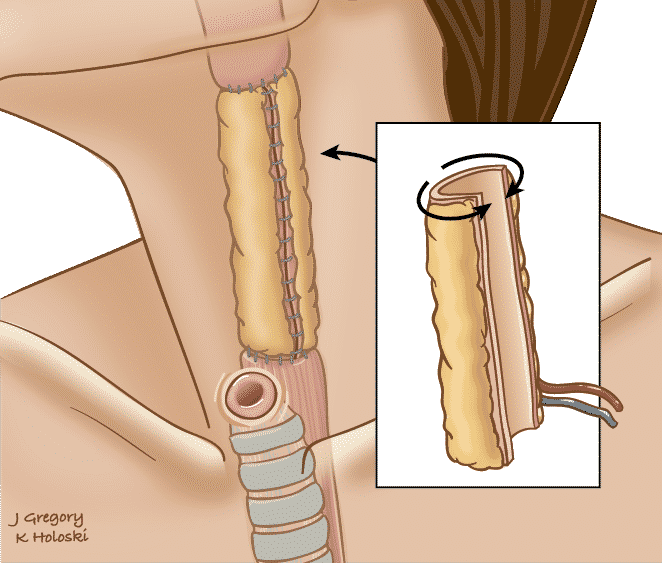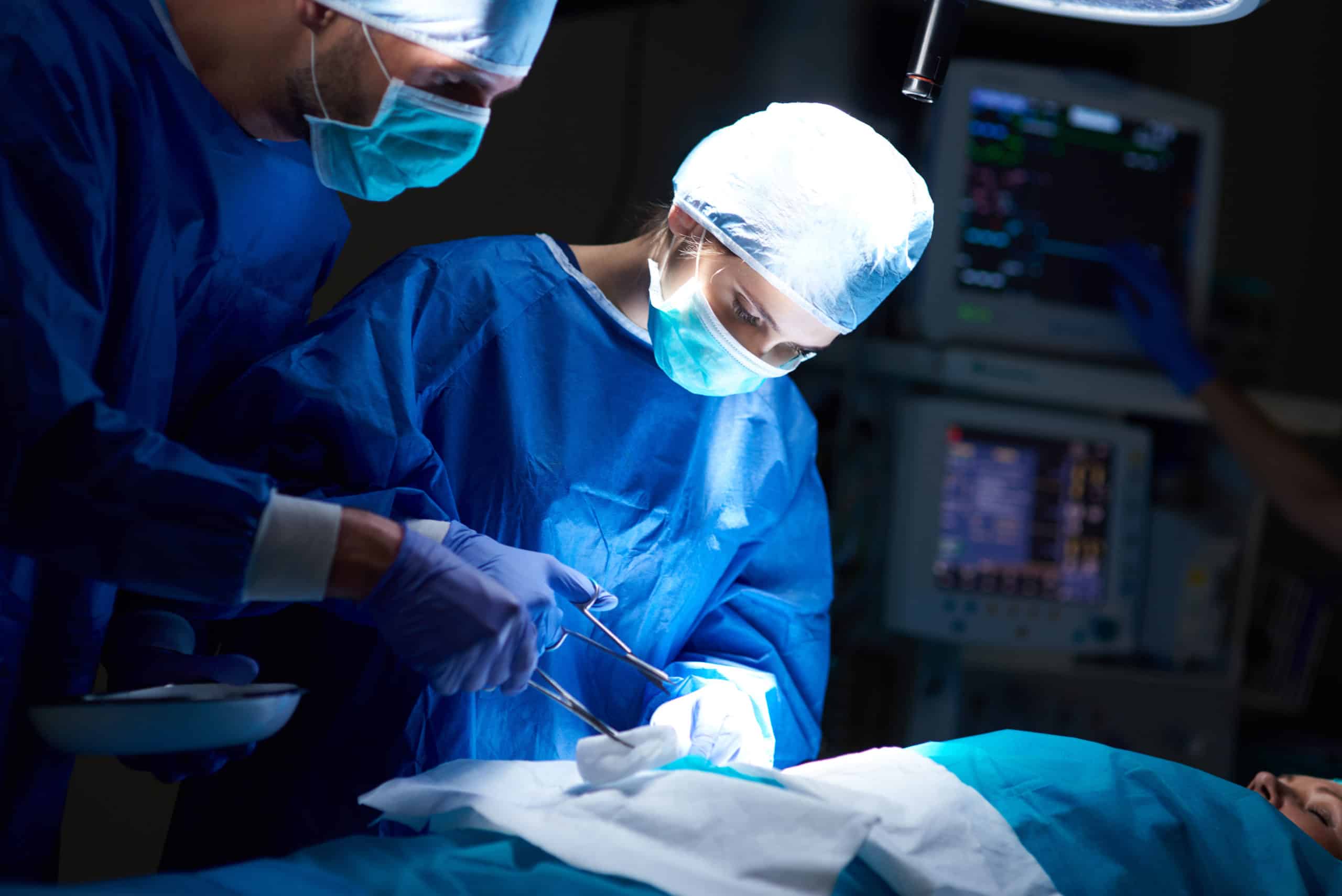Removing the Entire Voice Box
A total laryngopharyngectomy consists of the removal of the entire voice box and a portion of the pharynx (part of the throat behind the mouth and adjacent to the voice box). This typically only involves removal of the hypopharynx (bottom part of the pharynx), but part of the oropharynx (middle part of the pharynx) may need to be removed as well, depending on the extent of the tumor.
After the voice box and pharynx are removed, the trachea (windpipe) is sutured to the skin just above the sternum (breastbone), creating a permanent opening in the neck for breathing, similar to a total laryngectomy (as seen in the illustration below). However, because the pharynx is also removed, no direct connection remains between the mouth and esophagus. A reconstructive procedure is required to rebuild the pharynx to reconnect the mouth and esophagus so that the patient will be able to eat.

Surgical Reconstruction
There are several methods of reconstruction following a total laryngopharyngectomy, including a regional flap, a gastric pull-up, or a free flap. A regional flap consists of tissue from an area near the tumor site that is used to reconstruct the resected area while remaining connected to its regional blood supply. The most common regional flap utilized is a pectoralis major flap. A gastric pull-up is a procedure in which the stomach is pulled up through the chest to create a new throat, by connecting the stomach to the remaining portion of the pharynx. A free flap consists of tissue from an area distant from the tumor site that is used to reconstruct the resected area and requires microvascular surgery to restore its blood supply in the head and neck.
The free flaps most commonly used for this purpose are the radial forearm free flap and the anterolateral thigh free flap, in which the skin is turned into a tube to recreate the pharynx, as seen in the following illustration. In select cases, part of the small intestine (the jejunum) can be used for free tissue transfer as well.
There are a number of ways for patients to speak after their larynx (voicebox) has been removed (known as alaryngeal speech—speech without a larynx). Some possible techniques include a tracheoesophageal puncture, esophageal speech, or an electrolarynx. See the Speech & Swallow Rehabilitation page to learn more about speech options following the removal of the voice box.
Additional procedures performed during a laryngopharyngectomy might include neck dissections to remove lymph nodes or removal of a portion of the thyroid gland if the tumor is more extensive. In addition, a feeding tube will be placed at the time of surgery to use for nutrition while the reconstructed pharynx is given a chance to heal.
Preparing for Surgery
Doctors will give their patients specific instructions regarding what to do before surgery. In general, patients should not eat or drink anything (except essential medications) anytime after midnight the night before surgery. Patients should tell their doctor if they begin to feel sick before surgery.
Patients undergoing a total laryngopharyngectomy should have had a discussion with a speech and swallow therapist prior to surgery to discuss speech and swallowing rehabilitation following surgery.
What to Expect
On the day of surgery, the patient will likely be asked to arrive at the hospital a few hours before the scheduled operation. During this time, nurses will check the patient in and anesthesiologists will ensure that everything is safe for general anesthesia. The surgeon will also come see the patient to review the plan and answer any last minute questions.
The patient will be put completely to sleep with general anesthesia. For a total laryngopharyngectomy, the incision is made in the central neck. The larynx and a portion of the pharynx are removed in what is called the ablative part of the surgery. The surgeon may send some tissue at the margins of the resection for frozen section analysis to the pathology laboratory to ensure all the microscopic cancer has been removed.
Once the ablative part of the surgery is complete, the reconstructive component will begin. This involves harvesting the flap, insetting the flap to recreate the tube of the pharynx (as seen in the illustration above), and sewing blood vessels together to provide the flap with a blood supply.
At the end of the procedure, the surgeon will likely place one or more drains under the patient’s skin to remove any blood and/or fluid that might accumulate in the space adjacent to the reconstruction. These drains will be removed after a few days.
The patient will have a feeding tube inserted either through their nose, directly into their stomach, or through the tracheoesophageal puncture. At first, the patient will rely solely on the tube for nutrition. They will likely be able to resume eating by mouth after one or two weeks, depending on the extent of the surgery and the previous treatments that the patient has received.

Download This Section
Feel free to download and print this page.
It’s free for personal use and to share with others you think might benefit from the information provided.
Risks
As with any procedure, there are risks in undergoing a total laryngopharyngectomy:
- Bleeding (including Hematoma)
If there is severe bleeding after the procedure, the surgeon might need to quickly take the patient back to the operating room to stop the bleeding. However, some mild bleeding or small blood collections under the skin (hematomas) can be observed and managed conservatively. - Infection
Infections of the neck can occur after an extensive operation as described in this section. Prior exposure to radiation causes impaired wound healing and will lead to an increased risk of postoperative infection and salivary fistula. Management of an infection will likely involve antibiotics and/or drainage of the infection. In some instances, the patient will need to be taken back to the operating room to irrigate the wound. - Salivary Fistula
This term is used to describe when saliva is leaking from the pharynx (throat) into the neck. As noted above, the chances of this increase if a patient has had previous treatment including radiation and/or chemotherapy, which cause impaired healing. Typical treatment for a salivary fistula is to place a drain to divert the saliva away from critical structures in the neck and later to place packing into that diverted tract and let the body heal on its own. In some cases, an additional surgical procedure might be required to close the leak (such as a pectoralis major muscle flap). Wound vacs that provide negative pressure therapy to the wound may also be useful in managing this complication. - Hypocalcemia
Low calcium levels can occur postoperatively if both lobes of the thyroid are removed and all four parathyroid glands are removed during this process. Temporary hypocalcemia can also occur if remaining parathyroids are in a state of shock due to their blood supply being affected during surgery (temporary hypocalcemia). Calcium is important for the health and function of the bones, blood, muscles, heart, and nervous system, among others. This is why calcium levels need to be closely monitored after some total laryngectomies (or total laryngopharyngectomies) and calcium replacement may need to be given as needed. - Hypothyroidism
This can happen if both lobes of the thyroid gland are removed, if only one lobe is removed but the other lobe cannot make enough thyroid hormone, or if radiation treatment has affected the function of the thyroid gland. In any case, thyroid function can be measured with blood tests, and a once-daily pill can replace the function of the thyroid hormone. - Blood Clots
Patients who undergo major surgeries, especially patients who have cancer, are at an increased risk of developing blood clots in their legs (deep venous thrombosis or DVT). Sometimes these blood clots can travel through the veins and into the lungs, causing a pulmonary embolism (PE). If such a problem occurs, patients will likely require anticoagulation (blood-thinning) medication to prevent more clots from forming and ending up in their lungs.
Recovery & Aftercare
After surgery, the patient will remain in a closely monitored setting such as a post-anesthesia care unit or an intensive care unit. They will be given medication to control their pain. Most patients will remain in the hospital for one to two weeks following surgery.
Once doctors determine that a patient no longer needs in-patient level care, they will be ready for discharge. While some patients can go home from the hospital with or without visiting nurses or receiving home care, others might go to a rehabilitation or skilled nursing facility for a short while before going home. The discharge planning team, which includes doctors, social workers, nurses and physical therapists, along with the patient and their family, will determine the best place for the patient to go once they’re ready to leave the hospital.

Top Questions for Your Doctor
Access our list of the most important questions to ask your physician at your next appointment.











